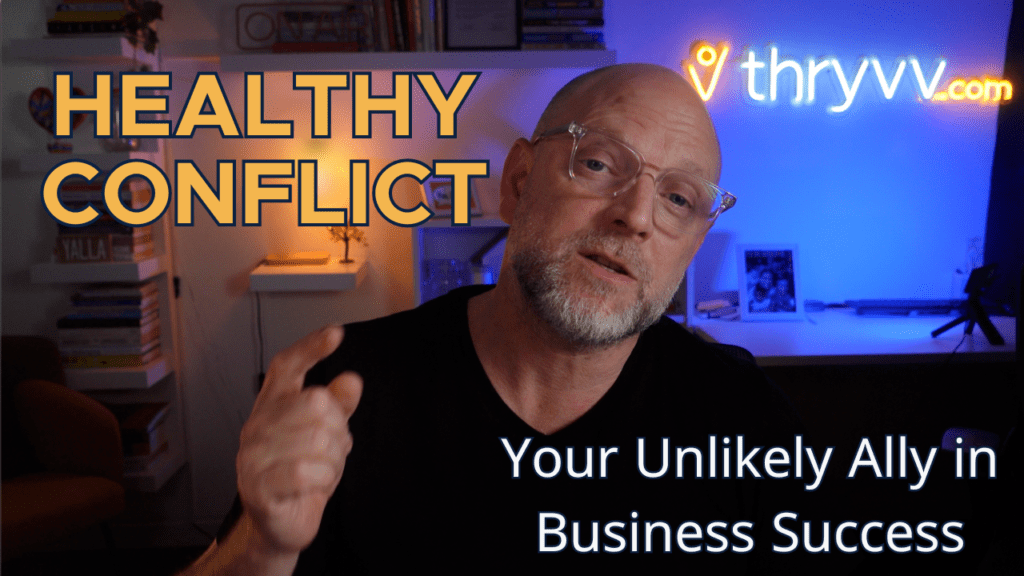
Embrace the Battle to Win the War
|“Engaging with conflict leads to a 12% increase in profitability.”|
You’re in it to win it. But here’s the twist: the battlefield isn’t always what you think. We’re taught to view conflict as the enemy of progress, yet this couldn’t be farther from the truth. When handled with care, conflict is the spark that ignites innovation and propels businesses to unprecedented success. This isn’t just talk—it’s backed by hard data. Shying away from conflict is like leaving money on the table. But first, make sure you’ve laid down a foundation of trust.
Patrick Lencioni said it best: “When there is trust, conflict becomes nothing but the pursuit of truth, an attempt to find the best possible answer.”
Shattering Illusions: The Hidden Cost of 'Peace'
Think conflict is bad? Think again. Harmony feels good, but it’s often just a veil for stagnation. Leaders who skirt around tough conversations are, in effect, detouring away from peak performance. Conflict isn’t the villain here; it’s the avoidance that’s the silent killer of growth.
Picture this: Co-founders who are like family dodging the hard talks. It’s natural, but it’s also a ticking time bomb. We’ve seen first-hand the fallout from unresolved issues—relationships and businesses crumble. It’s not just about the obvious clashes; it’s the everyday silence that builds an artificial peace. It’s about the resentment that simmers, and the candid words left unsaid.
In a candid highlight from an extensive interview for my upcoming book, a distinguished co-founder recounts their start-up odyssey and the dissolution of a partnership initially filled with reciprocal esteem.
Formerly in the corporate sphere and adjusting to life with a family, they felt a pull towards the meaningful mission of a nascent start-up, ultimately igniting a fervor that compelled them to take on the role of co-founder.
|”I’ve always had this kind of fire in me to build something on my own or to do something that matters.”|
Over time, the perception of shared values and vision that once seemed to align perfectly with their co-founder, began to reveal a more profound truth. What alignment there was, further eroded by the absence of frank, sometimes challenging dialogues. This gradual deterioration led to the tough decision to exit the venture they had painstakingly constructed. It was a move that signified not just personal pain, but also a pivotal event in the company, highlighting the fragile equilibrium necessary to sustain a co-founder bond.
The account, although very far from rare in the entrepreneurial landscape, underscores a critical, yet often-overlooked element of co-founder relations: the slow transition from radical collaboration to quiet strife and, eventually, parting ways.
The tale beneath their product’s apparent triumph is one of a developing fissure within their partnership, broadened by their reluctance to face conflict and engage in sincere exchanges—factors that precipitated this co-founder’s exit and loss of value for all.
|“We should have sat down and had an intentional conversation about how we want to be when we disagree.”|
Their story serves as a stark illustration of the repercussions of dodging conflict. Initially, their disparate strengths formed a perfect complement, yet as the business evolved, so did the gaps in their dialogue. Reflecting on lost chances for productive disputes, they recognized such opportunities were missed due to unfamiliarity with the concept amidst the earlier ease of their collaboration. The fallout from such avoidance was profound, culminating in a sense of betrayal within a partnership that was once defined by mutual admiration and common aspirations.
|”There’s only so much you’re going to take, and then at some point, you have to either work through it or you’re going to walk away from it.”|

Unearth the Tension to Strengthen the Foundation
Deep-seated grievances, when ignored, can cause a seismic shift in a company’s core. But when these tensions are brought to light, they can be addressed—transformed into pillars of strength and understanding. A systemic approach brings these issues to the surface in a safe space, turning potential discord into powerful bonds of alignment.
Marita Fridjhon says, “View conflict as a systemic event… a signal that change is needed and something new is trying to emerge.”
Conflict: The Gateway to Commitment and Accountability
Teams that tackle conflict head-on find themselves more committed to collective decisions. Intel’s legendary ‘disagree and commit’ mantra is a testament to this. Avoiding conflict leads to half-hearted commitments—like trying to help with tiny T-Rex arms. Not fully in. It’s ineffective and ultimately damaging. But when everyone’s voice is heard, even if there’s disagreement, commitment follows, paving the way for real accountability.
The Human Element: Why We Retreat and How to Advance
Our defences are ancient mechanisms designed to protect us. But in the modern boardroom, they do more harm than good. Recognising our defensive triggers is the first step toward dismantling them. By understanding our deep-seated need for significance and belonging, we can learn to regulate our emotional responses and foster a collaborative spirit.
Transforming Toxicity: The Turning Point of Leadership

I’ve lived this transformation. I went from a “hooligan CFO” to a leader who could sit with discomfort and use it as a tool for growth. This personal evolution is the essence of THRYVV’s philosophy: converting the raw energy of conflict and fear into the fuel for innovation and results.
My transformational journey, below, with my ex-colleague Amed, highlights the profound impact that unresolved conflict can have on leadership and team dynamics. Our clashes were not just personal; they reverberated through our teams, fostering an environment charged with tension and the threat of volatility over trivial matters like the placement of a coffee pot. This palpable toxicity, more than a mere personal vendetta, had the potential to erode the very fabric of our organisation—mirroring findings from MIT Sloan, that toxic behaviour is a far stronger predictor of team attrition than salary.
|” Toxicity is 10X a better predictor of attrition – losing you best people – than salary.”|
Recognising our destructive path and thanks to the development journey I’d started, I knew it was time to step out of my comfort zone. This being one of the most terrifying actions of my life, it sounds so trivial now, but as Feltman says in his amazing definition of trust:
“Choosing to risk making something you value vulnerable to another person’s actions” and vulnerability, takes courage. Something even special forces soldiers are clear on, there is no courage without vulnerability.
I turned to the principles taught me by Jim Tamm, my sage and Author of Radical Collaboration, and sought to understand the physiological precursors to my defensive reactions. A simple but powerful self-regulation technique—visualising a silverback gorilla to induce a moment of levity, well, internally laughing at myself for the aggressive masculine response that was autonomous in me—allowed me to step back from the brink of conflict. This shift from combativeness to composure reshaped the atmosphere within our teams, replacing tension with the possibility of collaboration.
The true test came when I stepped into the vulnerability, initiating a dialogue with Amed that was as daunting as it was necessary. Not to put too fine a point on it, I was absolutely crapping myself, terrified of humiliation, or worse. To be a bit more academic about the process, it involved exposing my insecurities and expressing the personal impact of our interactions.
While this honesty did not magically fix years of discord, it marked the start of a gradual dissolution of the toxicity that had plagued our teams. Now, reflecting on a journey that once seemed insurmountable, Amed and I stand as evidence that the most entrenched conflicts can be navigated towards a place of mutual respect and cooperation, significantly enhancing the cohesion and retention of our teams. We are still in touch and meet up when we can for a coffee and catchup – and greater than that, he asked me for help on something recently.
Strategies for Constructive Confrontation
There’s an art to managing conflict. It’s not about avoiding or dominating; it’s about choosing the right approach for the moment. Here are five strategies that can help:
- Accommodation: Sometimes, laying down your arms can build a stronger alliance for the future.
- Pausing: Knowing when to step back is as important as knowing when to step up, for example, when emotional regulation is required.
- Collaboration: Finding the win-win is the ideal, where shared goals become the team’s North Star.
- Competition: In critical moments, a firm stance can be the most effective.
- Compromise: When immediate solutions are needed, meeting in the middle is a pragmatic choice.

Proactive Planning: The Blueprint for Conflict Mastery
By establishing clear conflict management protocols in advance, a team can weather any storm. It’s about creating a culture that sees conflict as a stepping stone rather than a stumbling block. This strategic foresight is what sets THRYVV apart, ensuring that every disagreement is handled with intention and empathy.
Invitation to Action: Embrace Conflict, Ignite Growth
Don’t shy away from the uncomfortable. Embrace it. It’s in these moments that true leadership is forged. By welcoming healthy conflict, you unlock the door to innovation and drive your company forward. Equip yourself with the tools and understanding to transform every challenge into an opportunity for unity and growth. Join us at THRYVV, and let’s write the next chapter of your leadership story—one where conflict is not the enemy, but the ally to success.
Three Steps to Cultivating Conflict Mastery
- Awareness and Defencelessness:
Embrace self-awareness. Notice when you’re on the defensive.
Ask yourself, “What’s triggering my defences, and what am I protecting?”
Cultivate a culture of openness, where everyone feels safe to express vulnerabilities.
- Designing a Team Alliance:
Define how you want to engage in conflict as a team.
Ask, “What does successful conflict resolution look like for us?”
Consider, “How can we hold each other accountable in a supportive way?”
- Skilful Communication:
Teach and practice the art of expressing conflict constructively:
- Frame the issue: “This is difficult for me because… and it’s important to me because…”
- Describe specific behaviours without assigning blame.
- Share your feelings and the impact on you.
- Then, listen. Really listen.
Your Path to Profitable Healthy Conflict
Choosing to engage with conflict is choosing a profitable future. It’s a strategic decision that, as Jim Tamm’s research shows, leads to a 12% increase in profitability.
Are you fed up with not hitting goals? Imagine a culture where you hear, “I disagree, and I don’t get what you are saying, let’s explore this more”.
Note: Some of the names may have been changed to honour confidentiality.
Check out my video on this topic on YouTube: https://youtu.be/iJhMwcAmXdM
